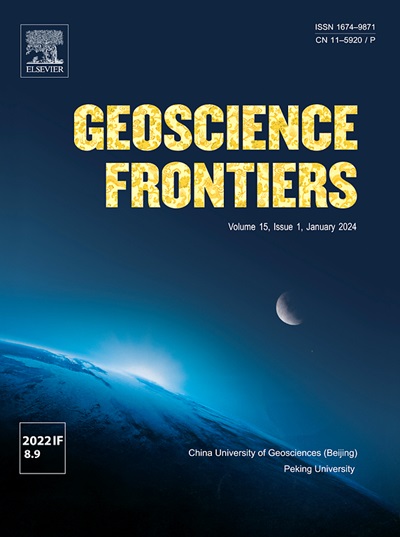Hydrochemical characteristics, driving factors and health risk of fluoride in groundwater from the northwestern Ordos Basin, China
IF 8.9
1区 地球科学
Q1 GEOSCIENCES, MULTIDISCIPLINARY
引用次数: 0
Abstract
Groundwater is essential for maintaining public health, promoting economic development, and ensuring ecosystem stability in arid and semi-arid regions. The northwestern Ordos Basin (China) primarily relies on groundwater from multilayered aquifer systems; however, our knowledge of the hydrochemical characteristics and water quality of groundwater in this region is limited. Here, we employed a newly collected dataset of 94 groundwater samples from different aquifers to constrain the source, controlling processes of fluoride in groundwater, and its potential health risk in the area. Groundwater is characterized by Na-Cl and Na-SO4 types with a minor Na-HCO3 type, which is primarily controlled by ion exchange, silicate weathering, and the dissolution of carbonate and evaporite minerals. Of the groundwater samples, 42% exceeded the fluoride limit of 1.5 mg/L established by the World Health Organization (WHO). This is mainly attributed to geogenic sources, including fluorine-bearing mineral dissolution, cation exchange, evaporation, and competitive adsorption. The water quality index suggests that most samples are unsuitable for drinking. Health risk assessment results based on the Monte Carlo simulation indicate that children face significantly higher non-carcinogenic health risks from fluoride exposure than adults (both males and females). These findings provide new insights into the complex hydrogeochemical evolution of fluoride in groundwater and the groundwater quality status in multi-aquifer systems, contributing to the sustainable development and management of groundwater resources in the Ordos Basin.

鄂尔多斯盆地西北部地下水氟化物水化学特征、驱动因素及健康风险
在干旱和半干旱地区,地下水对维持公众健康、促进经济发展和确保生态系统稳定至关重要。鄂尔多斯盆地西北部主要依靠多层含水层系统的地下水;然而,我们对该地区地下水的水化学特征和水质的了解有限。本研究采用新采集的94个不同含水层地下水样本数据集,对该地区地下水中氟化物的来源、控制过程及其潜在健康风险进行了约束。地下水以Na-Cl和Na-SO4型为主,次要为Na-HCO3型,主要受离子交换、硅酸盐风化、碳酸盐和蒸发岩矿物溶蚀作用控制。在地下水样本中,42%超过了世界卫生组织(WHO)规定的1.5 mg/L的氟化物限量。这主要归因于含氟矿物溶解、阳离子交换、蒸发和竞争性吸附等地质成因。水质指数显示大部分样本不适合饮用。基于蒙特卡罗模拟的健康风险评估结果表明,儿童因接触氟化物而面临的非致癌性健康风险明显高于成人(男性和女性)。研究结果为鄂尔多斯盆地地下水中氟化物的复杂水文地球化学演化及多含水层系统地下水水质状况提供了新的认识,为地下水资源的可持续开发与管理提供了依据。
本文章由计算机程序翻译,如有差异,请以英文原文为准。
求助全文
约1分钟内获得全文
求助全文
来源期刊

Geoscience frontiers
Earth and Planetary Sciences-General Earth and Planetary Sciences
CiteScore
17.80
自引率
3.40%
发文量
147
审稿时长
35 days
期刊介绍:
Geoscience Frontiers (GSF) is the Journal of China University of Geosciences (Beijing) and Peking University. It publishes peer-reviewed research articles and reviews in interdisciplinary fields of Earth and Planetary Sciences. GSF covers various research areas including petrology and geochemistry, lithospheric architecture and mantle dynamics, global tectonics, economic geology and fuel exploration, geophysics, stratigraphy and paleontology, environmental and engineering geology, astrogeology, and the nexus of resources-energy-emissions-climate under Sustainable Development Goals. The journal aims to bridge innovative, provocative, and challenging concepts and models in these fields, providing insights on correlations and evolution.
 求助内容:
求助内容: 应助结果提醒方式:
应助结果提醒方式:


